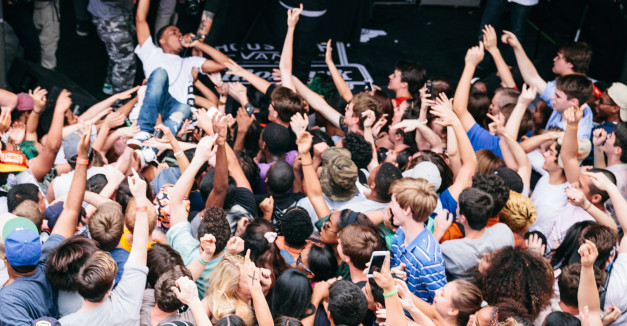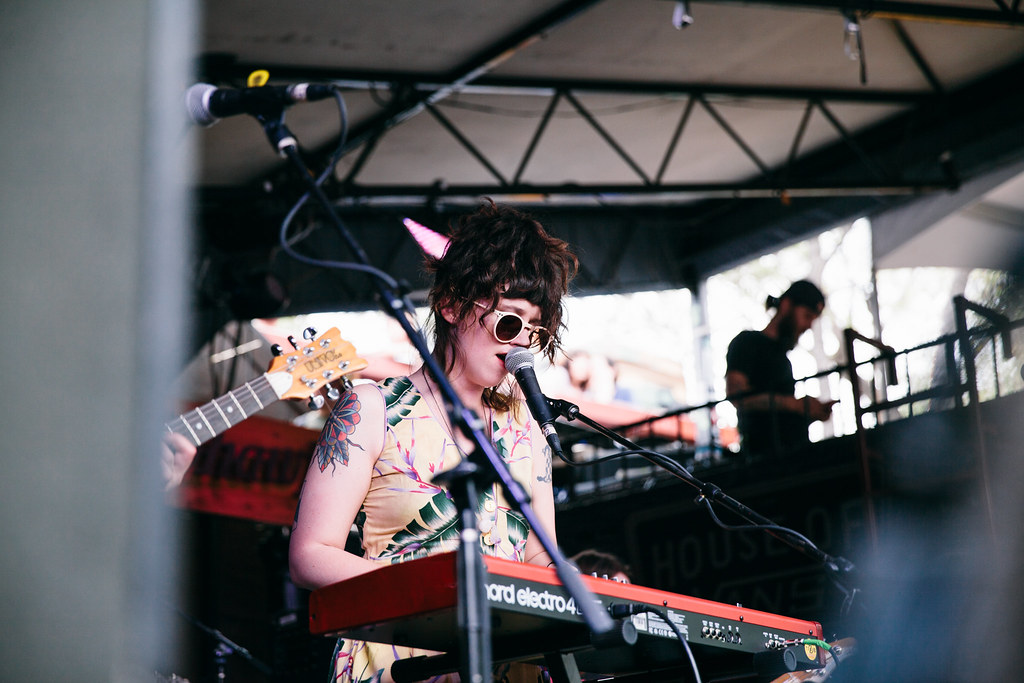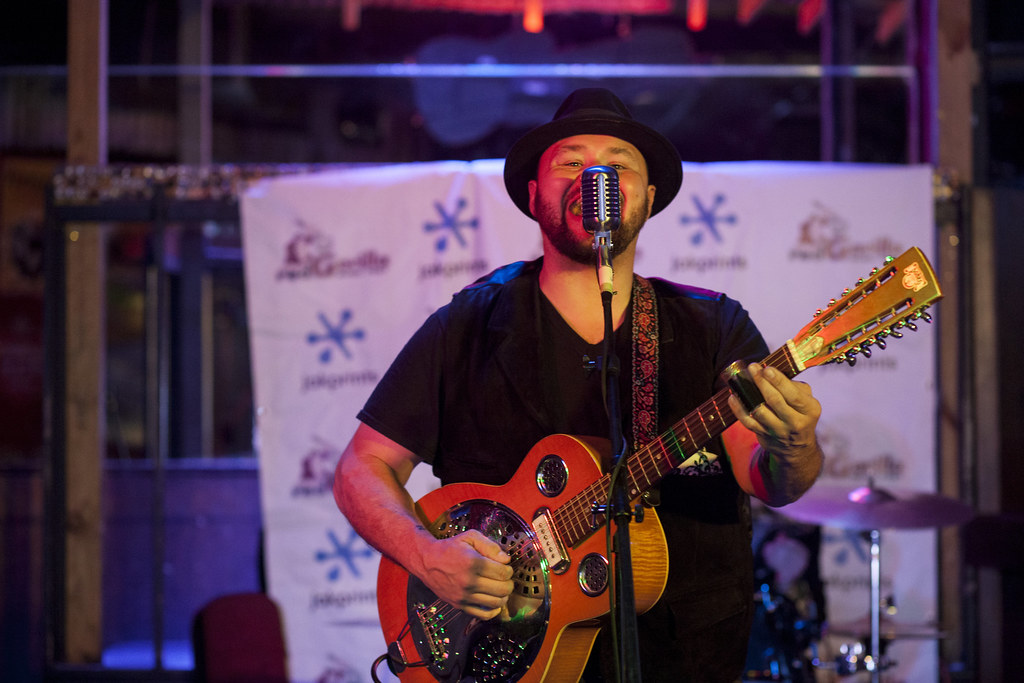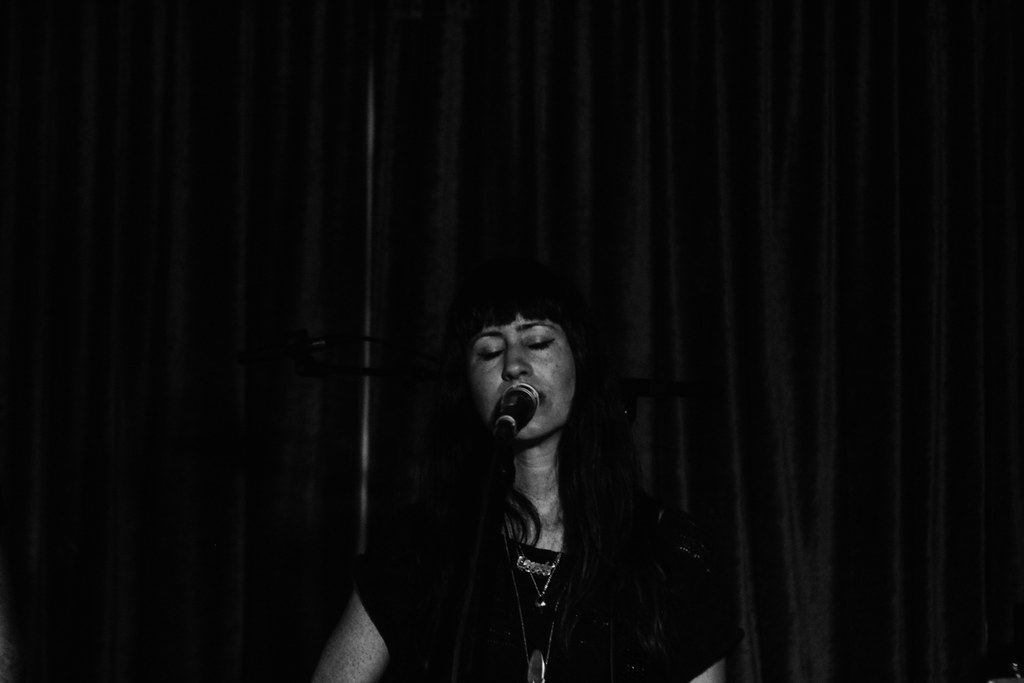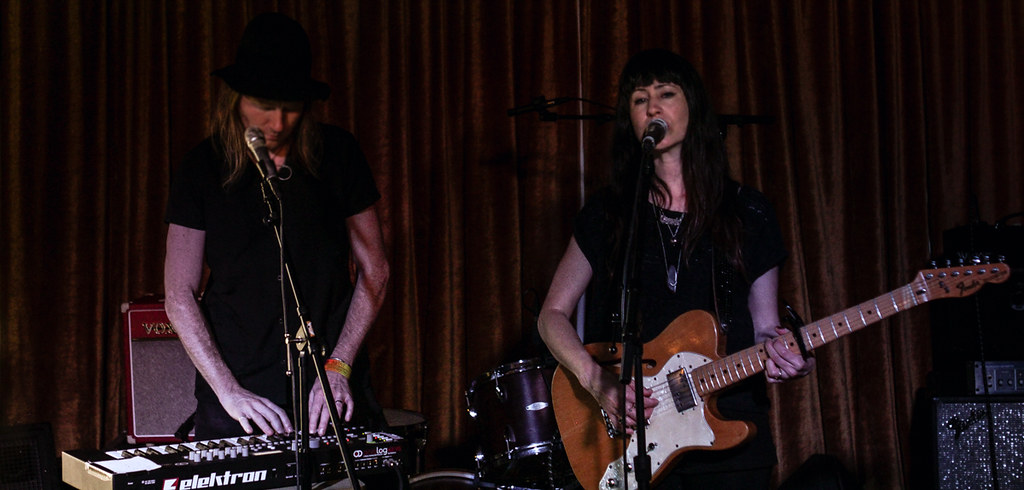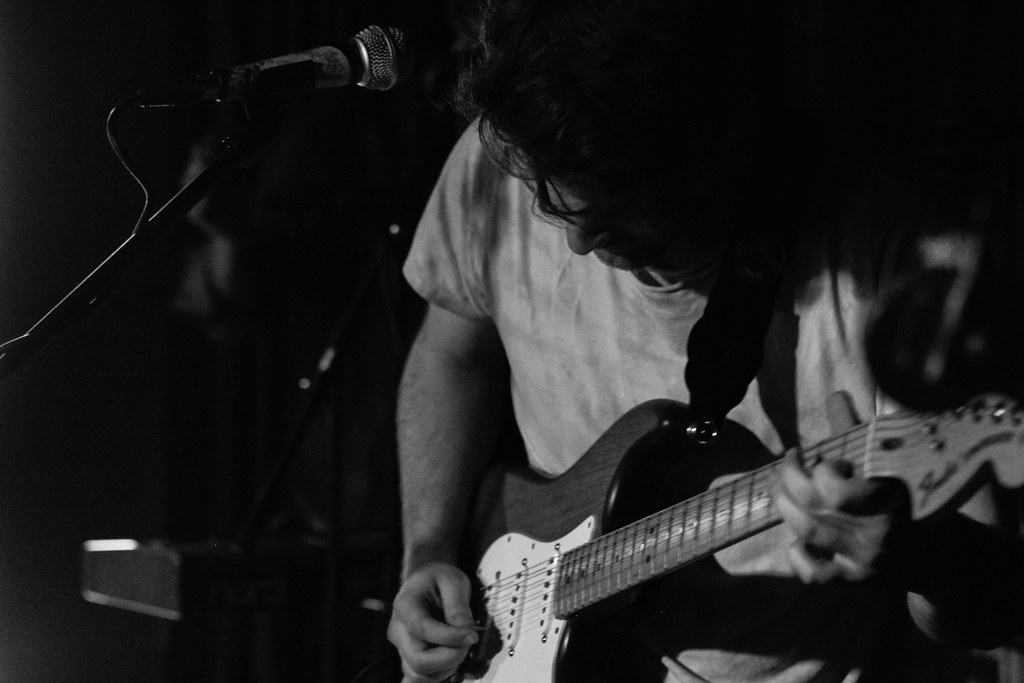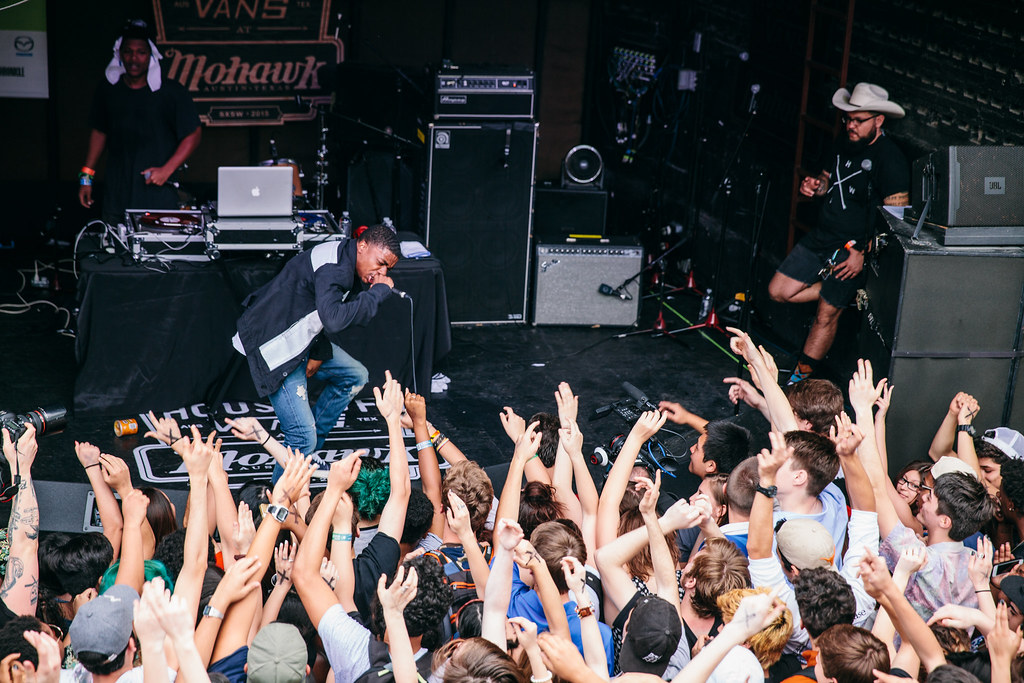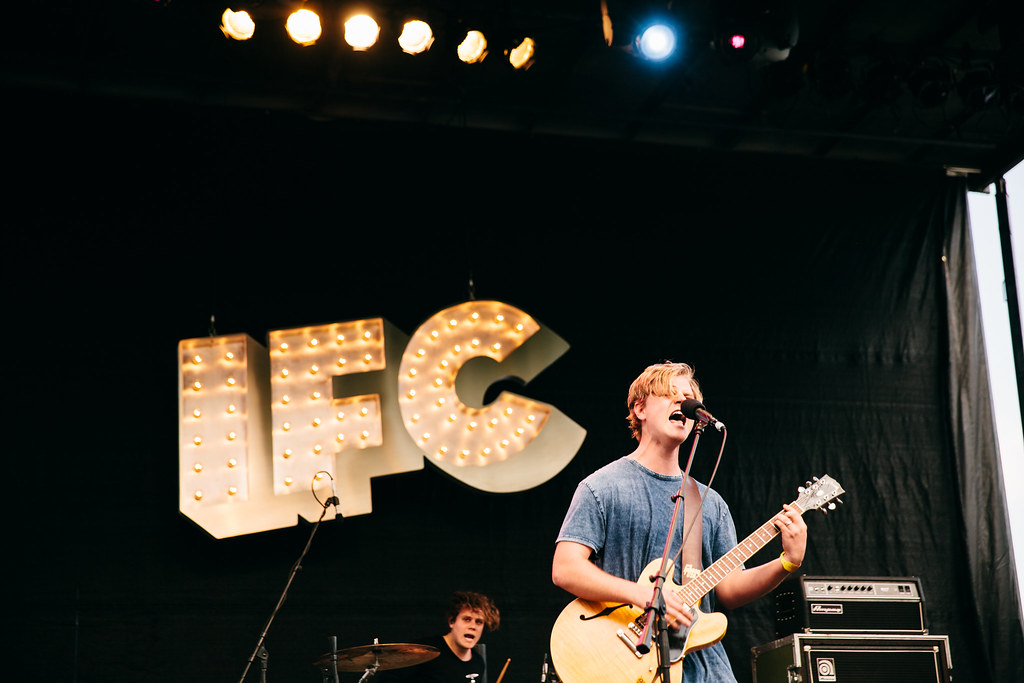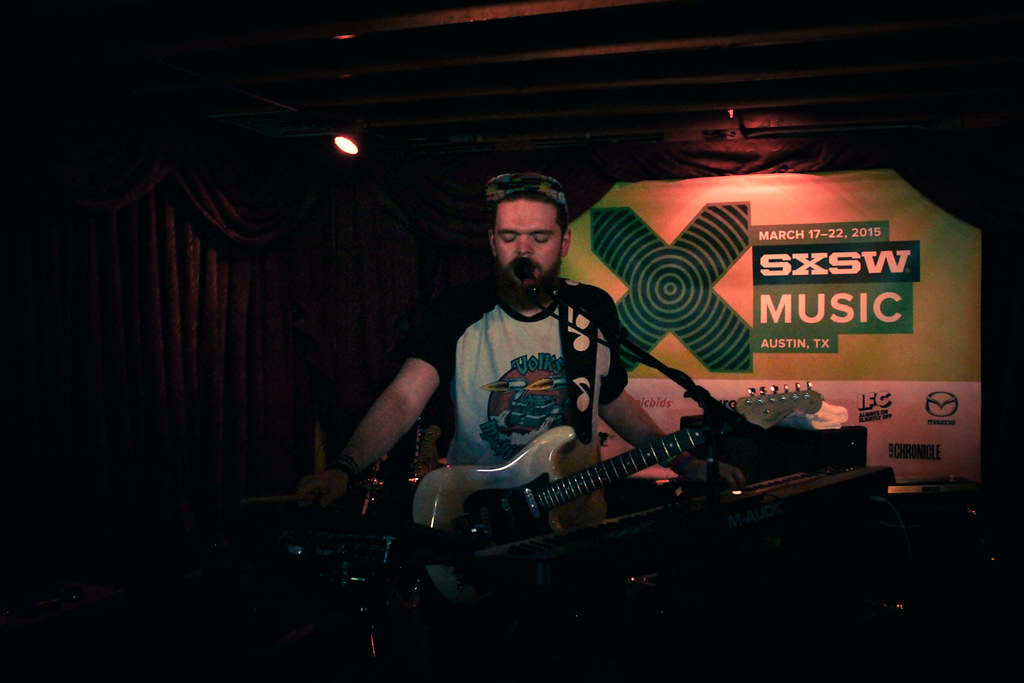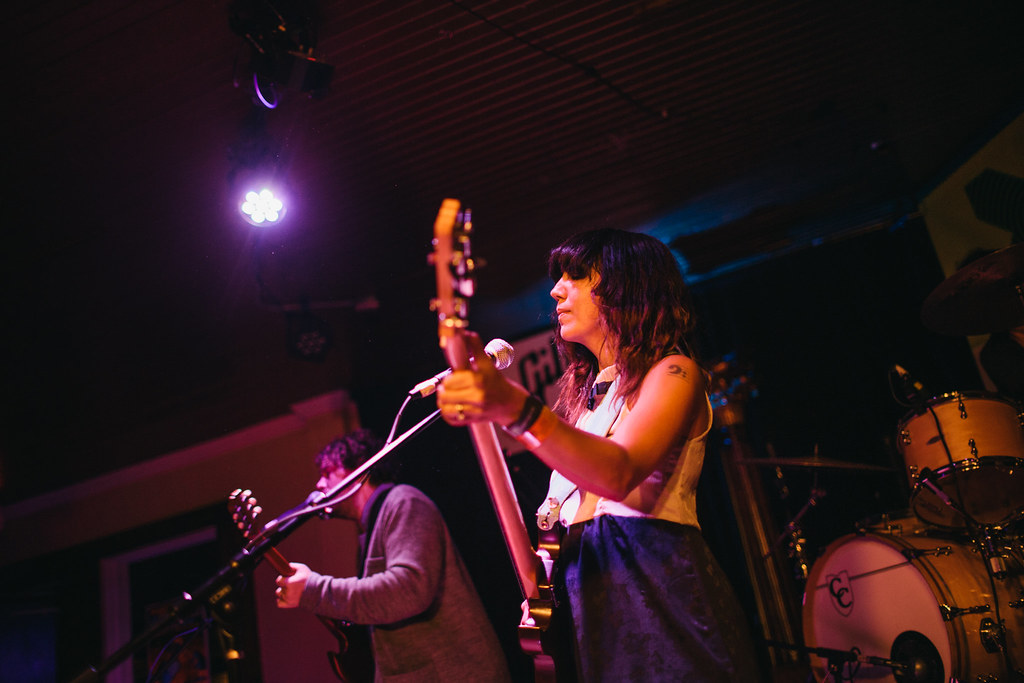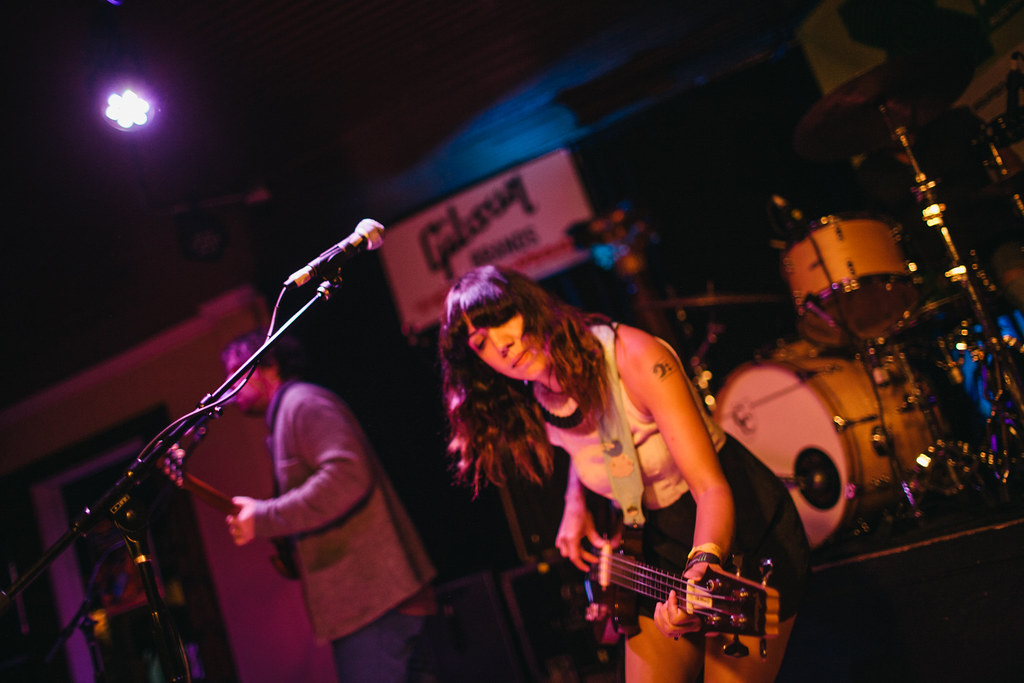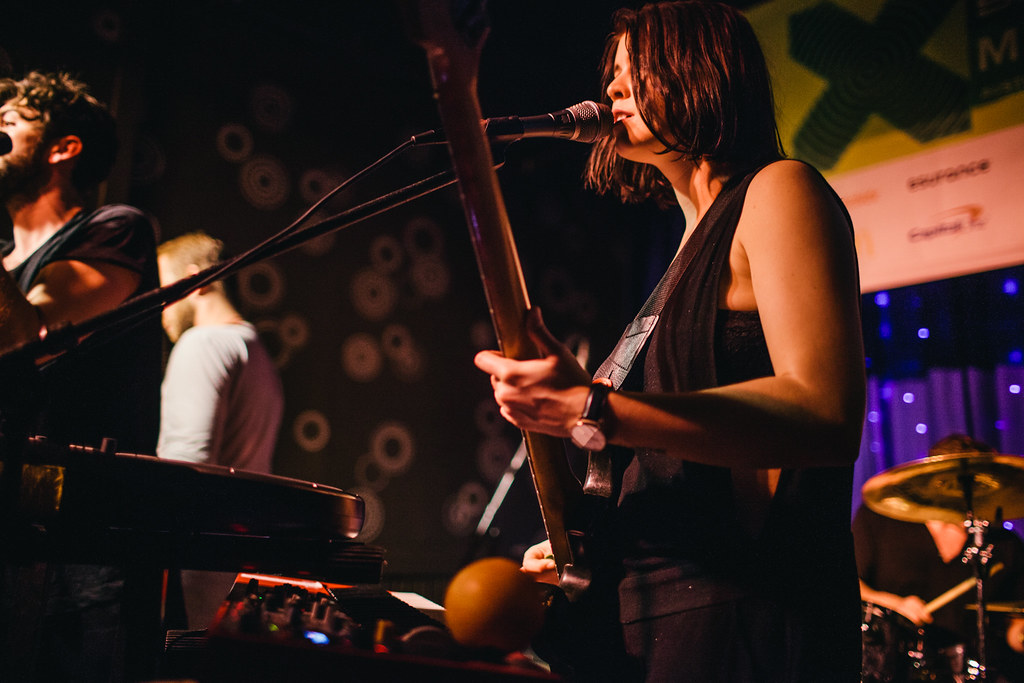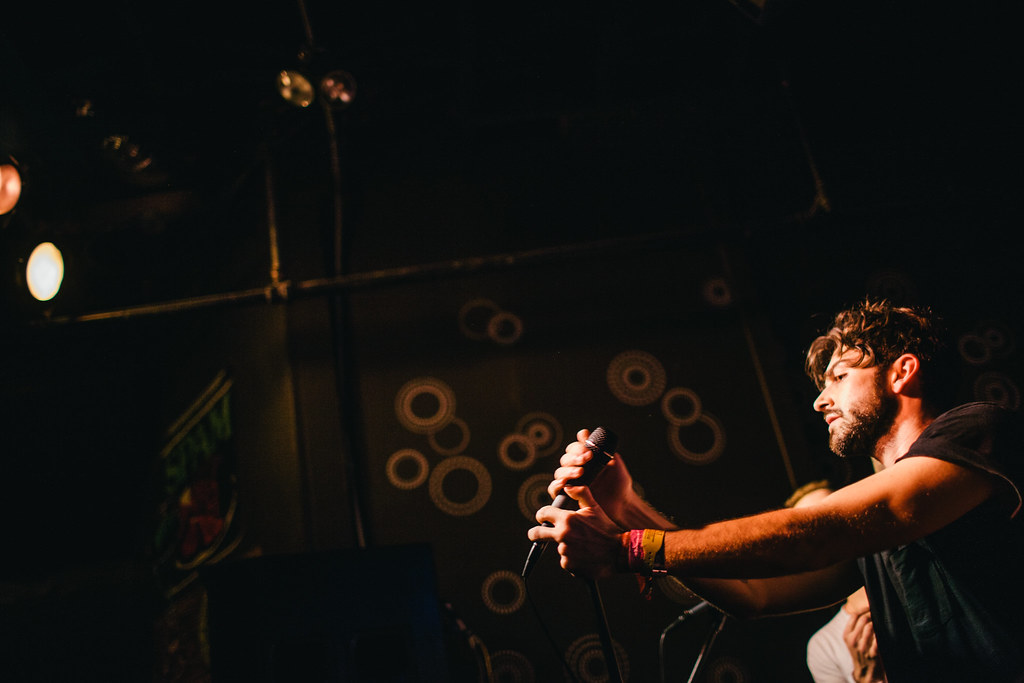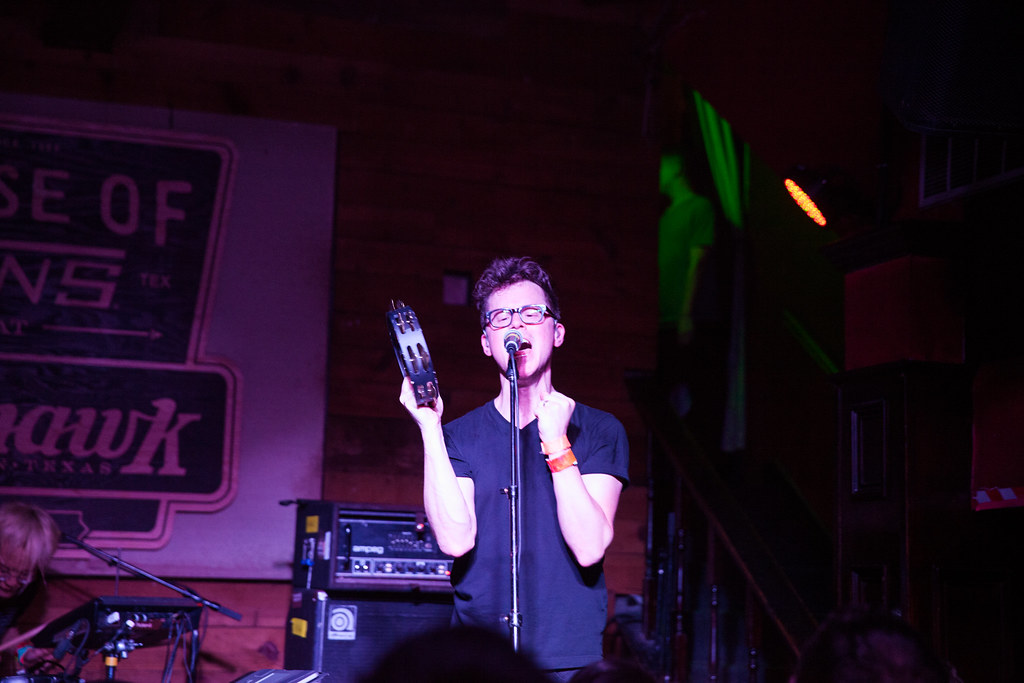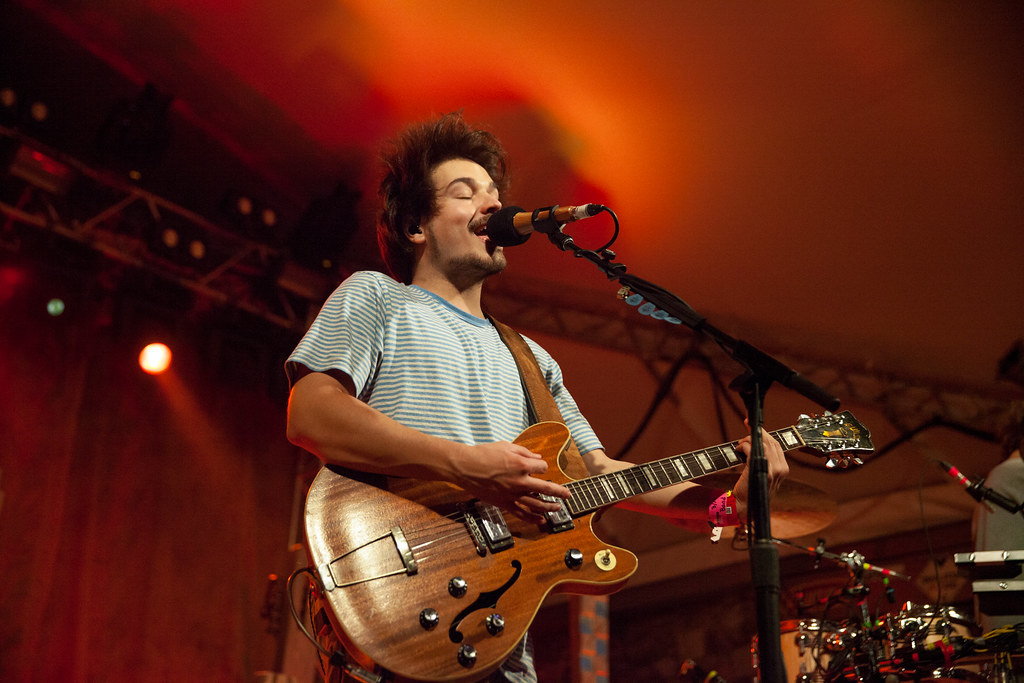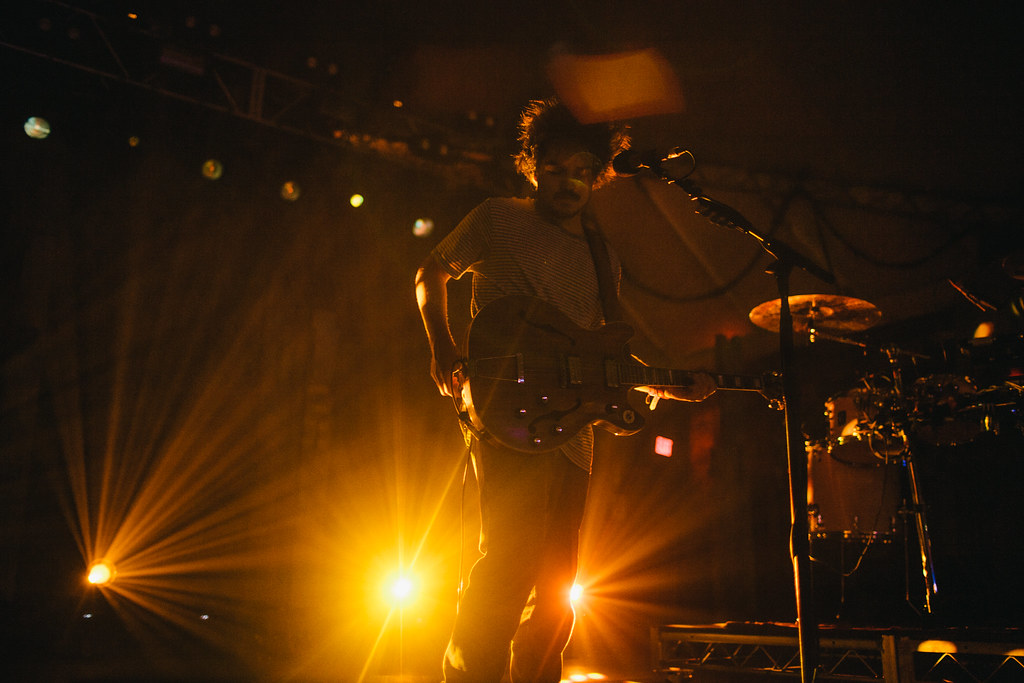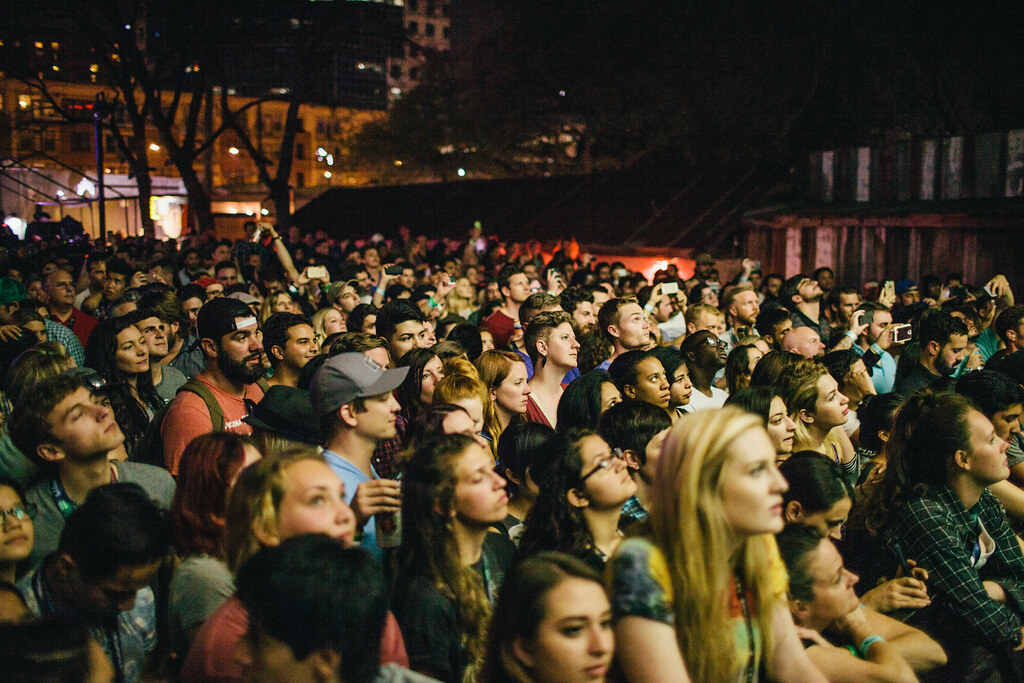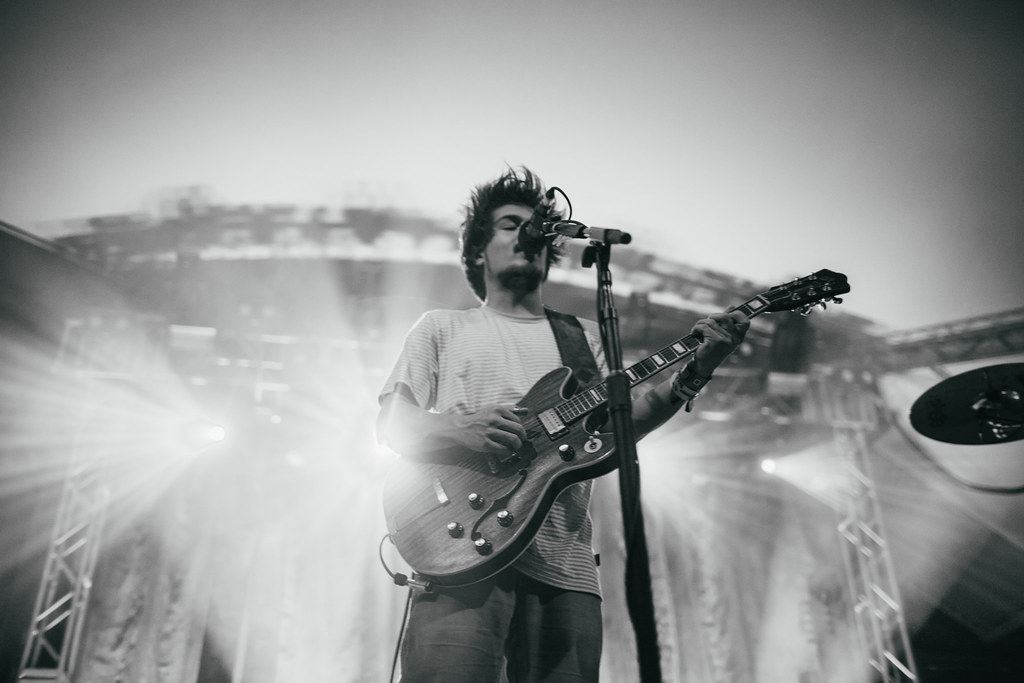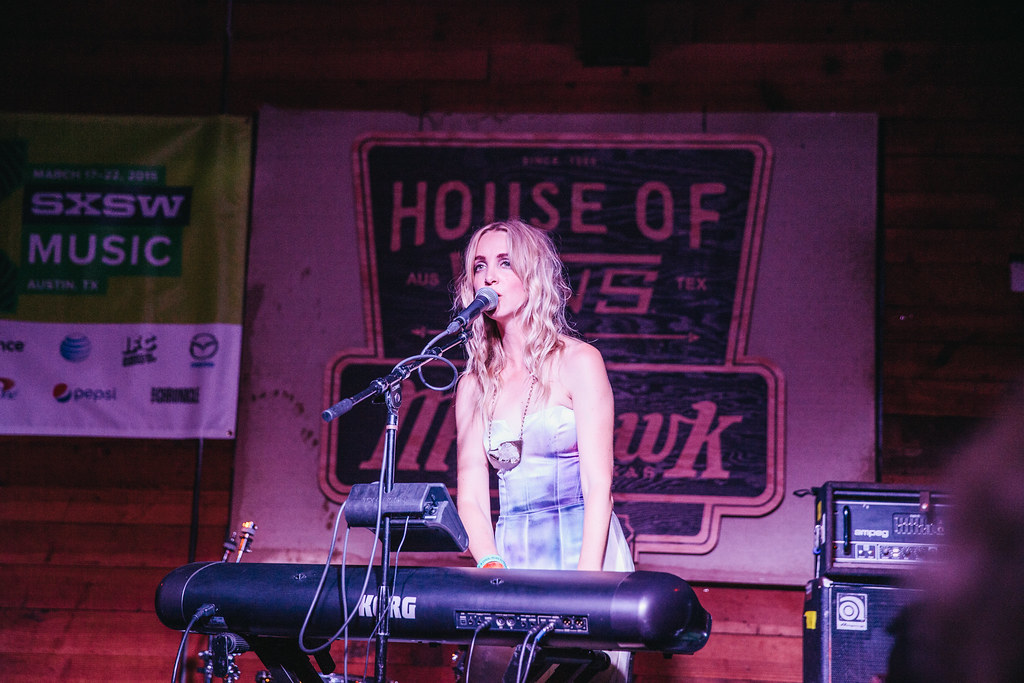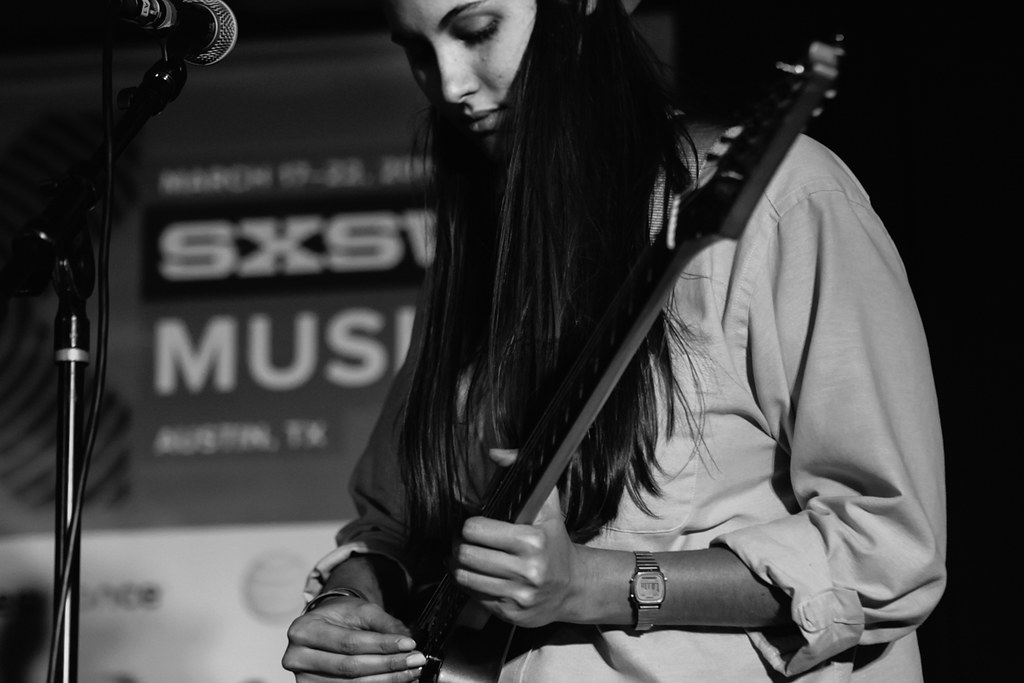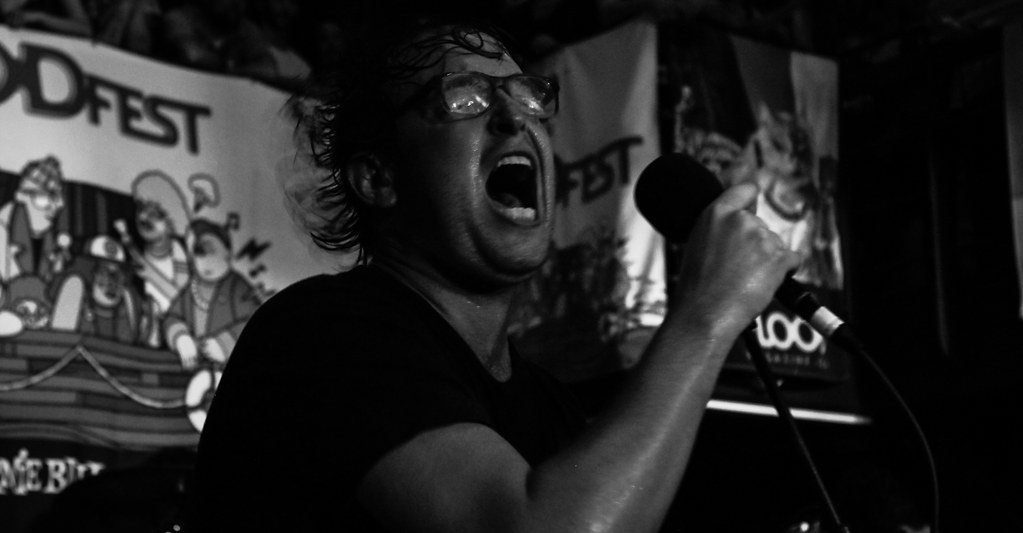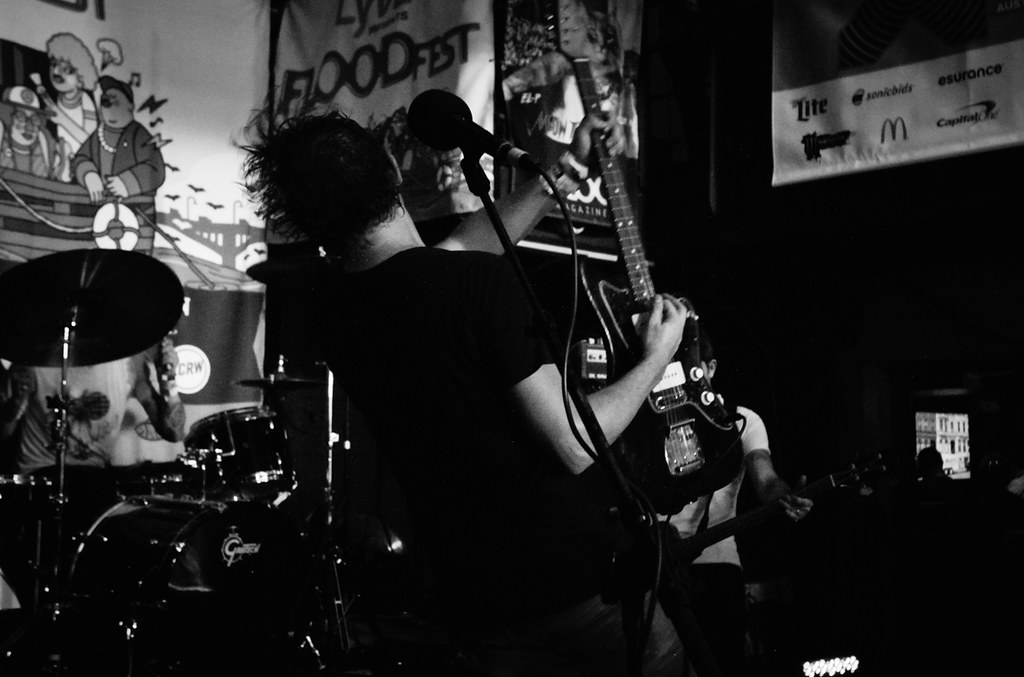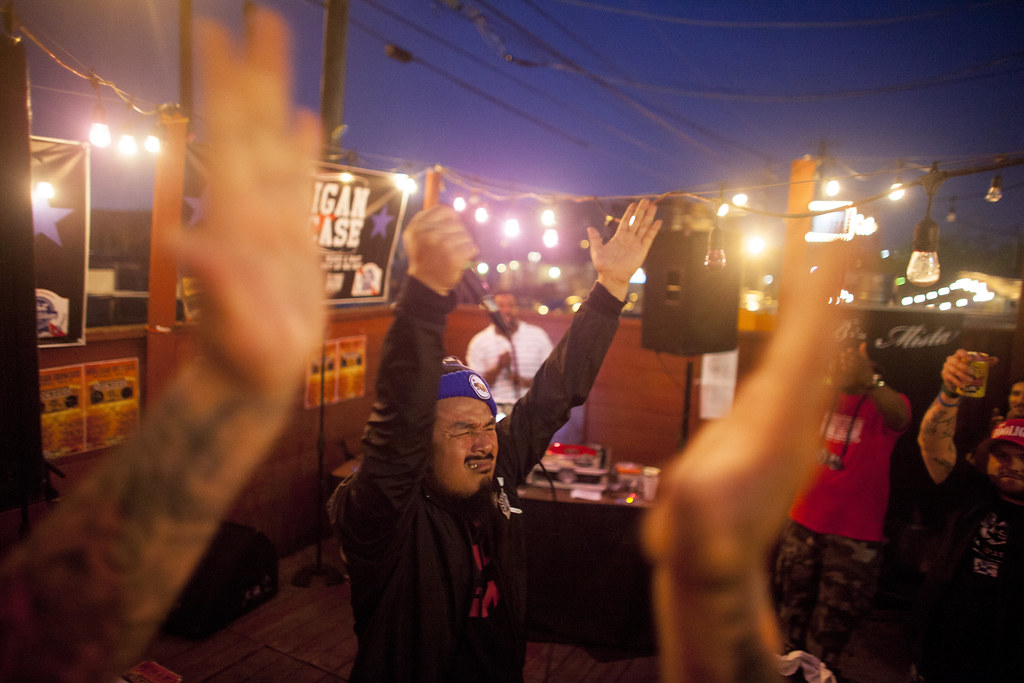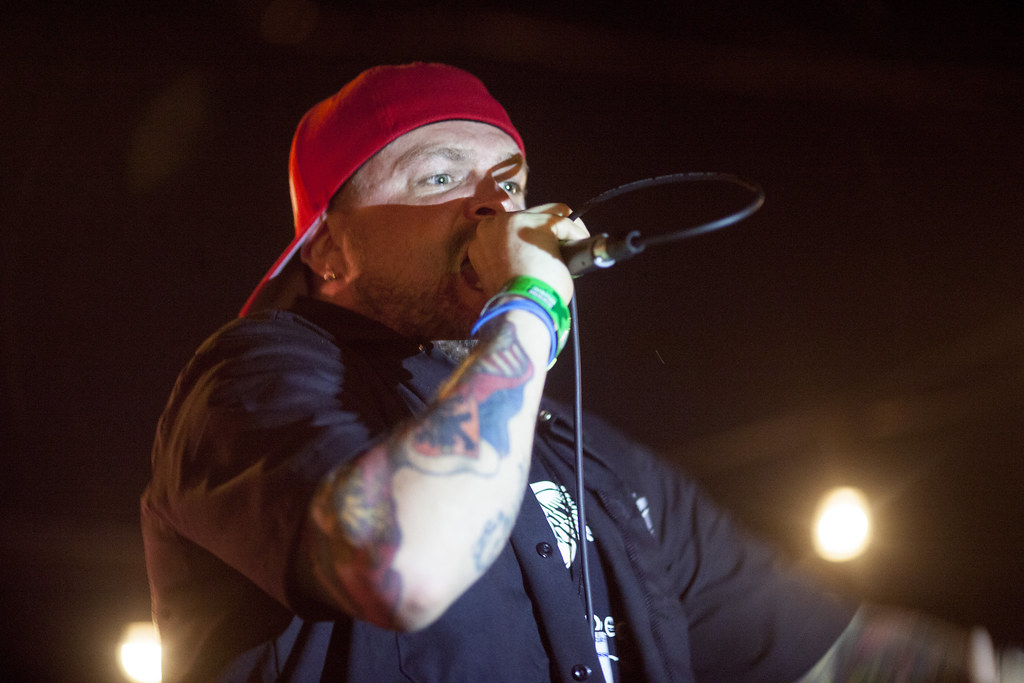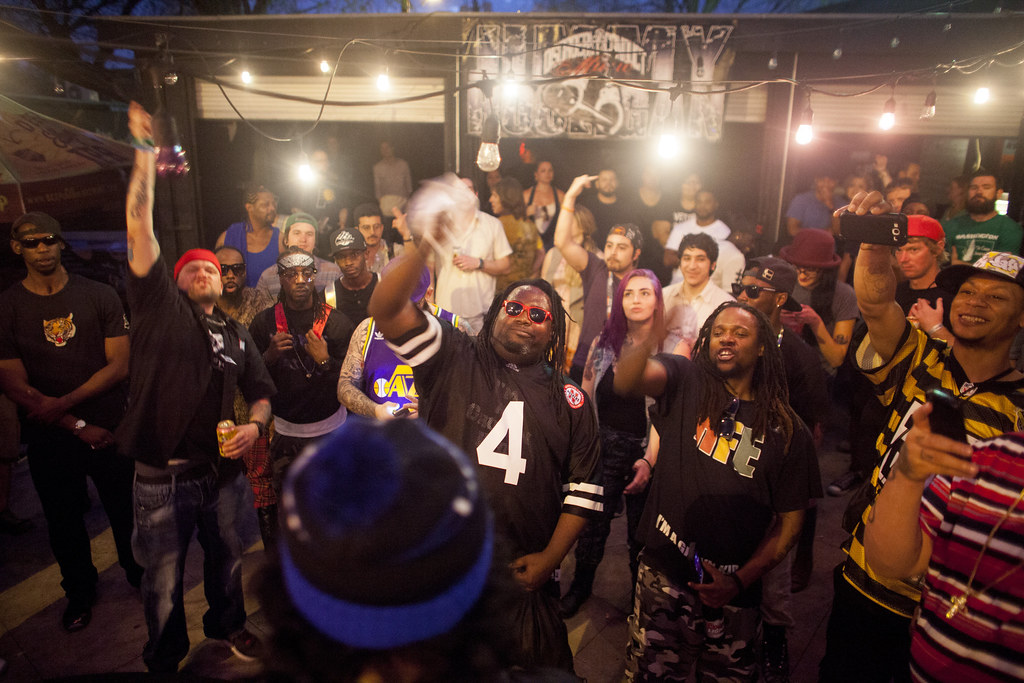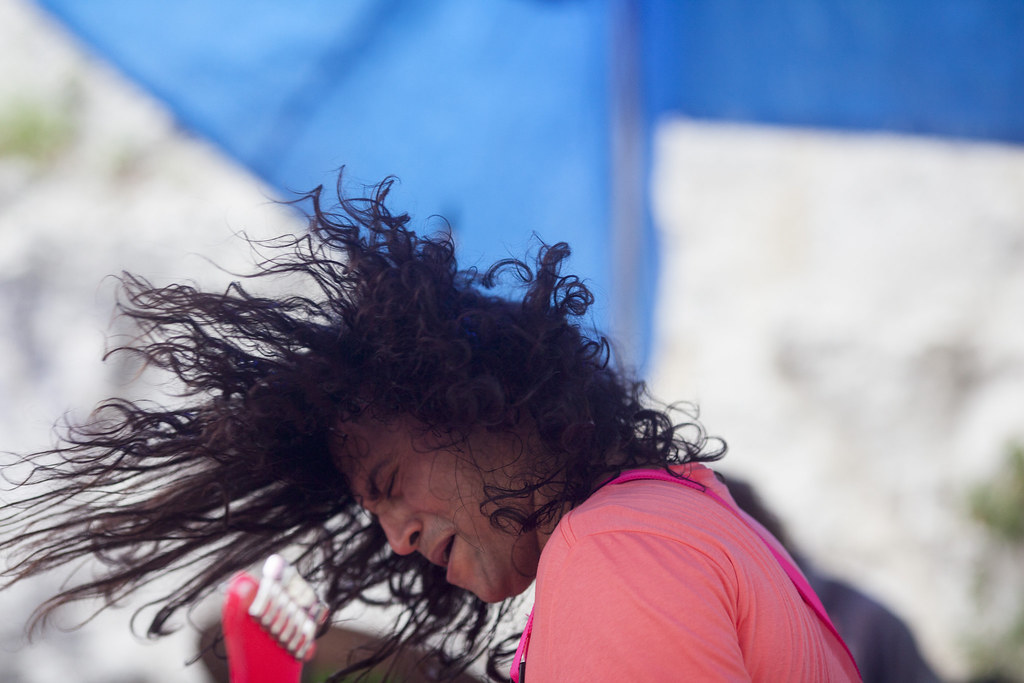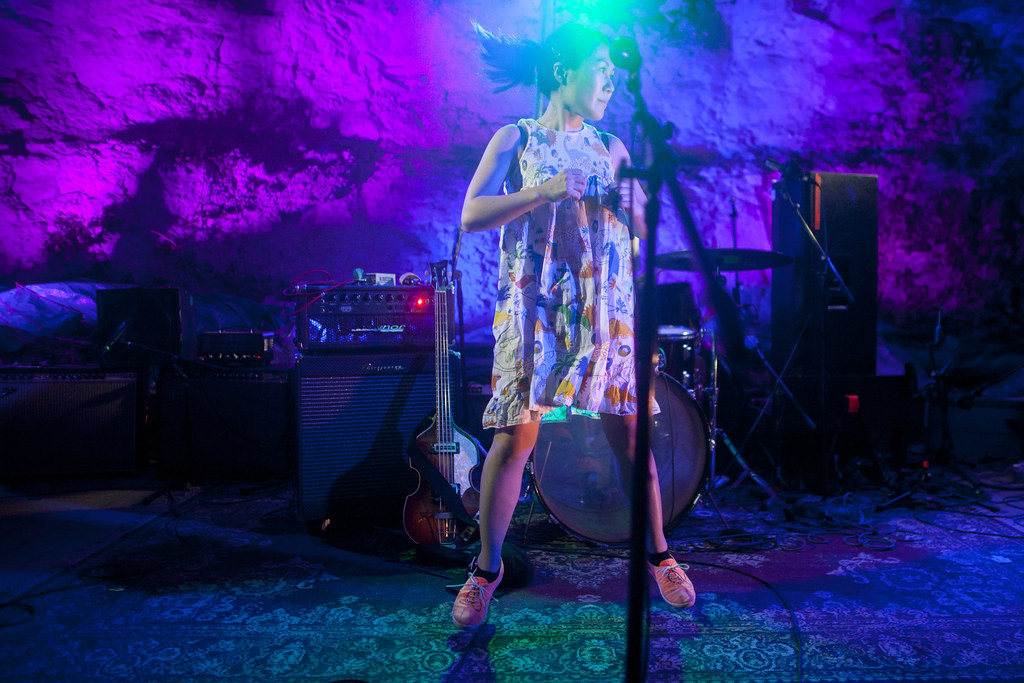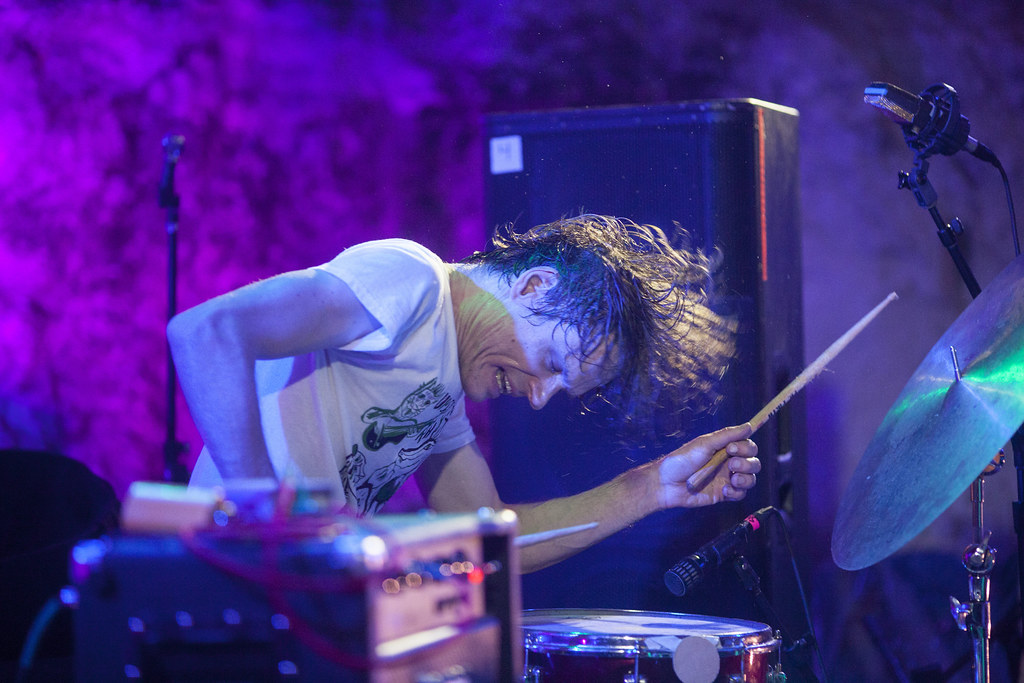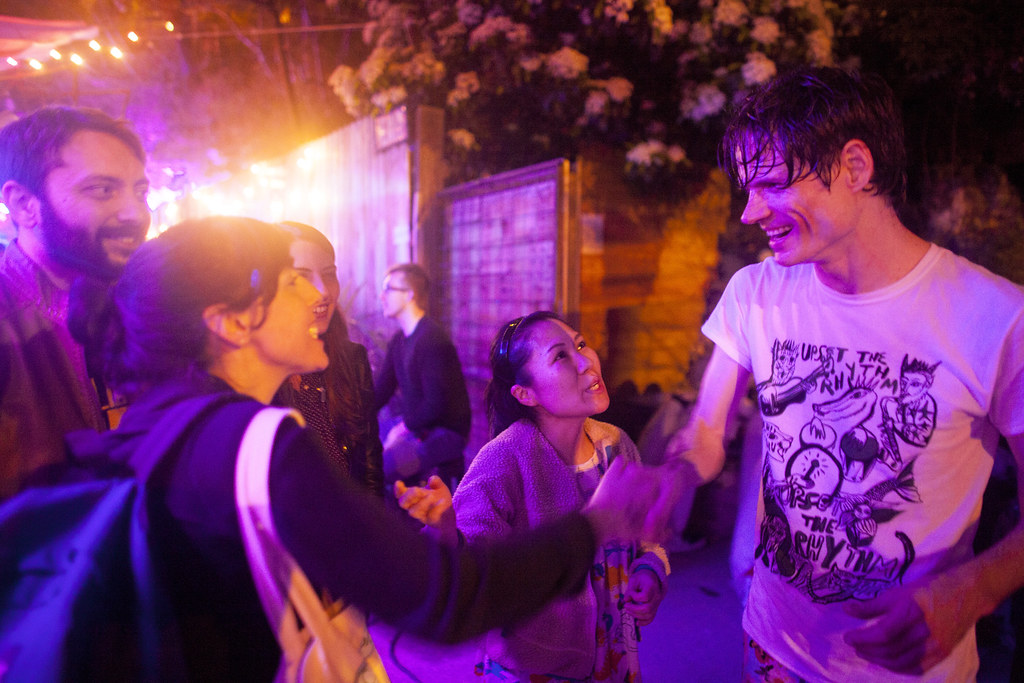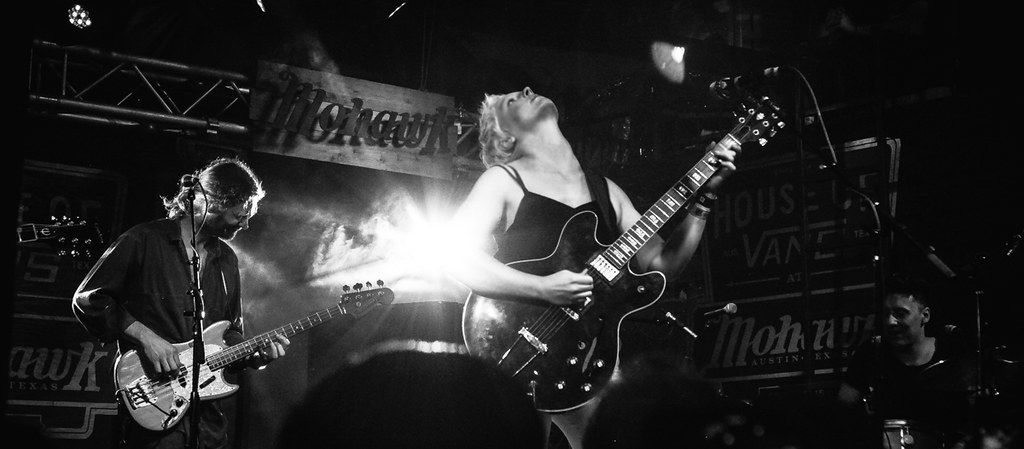The Hear Nebraska team shot more than 4,000 photos yesterday. That’s the level of elbow grease that goes into covering SXSW. Check it out below.
* * *
Waxahatchee at Mohawk
When last Omaha saw Katie Crutchfield’s Waxahatchee project, the frontwoman was playing at The Waiting Room 11 months ago — a mostly solo set.
Now, as she prepares to release Waxahatchee’s third album, this April on Merge, it’s hard to imagine what the new songs would even sound like solo after seeing her at Mohawk on Thursday afternoon. One person clubbing chords and straining a voice? But that’s the point. Crutchfield’s full five-piece band is opening a door on gaping classic rock.
A nice venue fit, the songs were pushed upward by twin vocals and what often amounted to three rhythm guitars, elevating the plain of the songs up to the first, second and third levels of the venue’s balcony standing.
Crutchfield’s voice is an expression of power, but there’s a lot of room for tinkering in these songs, as the band shows with some moving guitar lines on “Peace and Quiet” from Cerulean Salt.
—Chance Solem-Pfeifer
photo by Bridget McQuillan
* * *
Hector Anchondo Band at Dizzy Rooster
At Dizzy Rooster yesterday afternoon, Hector Anchondo tells a story about his 12-string steel guitar. The gist is that it chose him, and he’s been playing it ever since. He speaks reverently, as though his accomplishments, his very presence at SXSW, is credited to the guitar rather than years of practice.
It’s hard to tell who, if anyone, in the bar is listening. Anchondo, bassist Carl Brown and drummer Khayman Winfield are on a small stage tucked to the front of the long, narrow bar. The seven or eight people at Dizzy Rooster are mostly clustered around the entrance where people watching out onto Sixth Street.
A couple college basketball games are on TV and the sound person idly scrolls on his phone.
Among some 3,000 bands playing in and around downtown Austin this week, sheer numbers mean that many acts are playing to this kind of crowd. And likely, they have a similar story to Hector Anchondo Band. They are perhaps popular in their home region and successful in a certain national niche. Anchondo and crew recently made semi-finals at the International Blues Challenge.
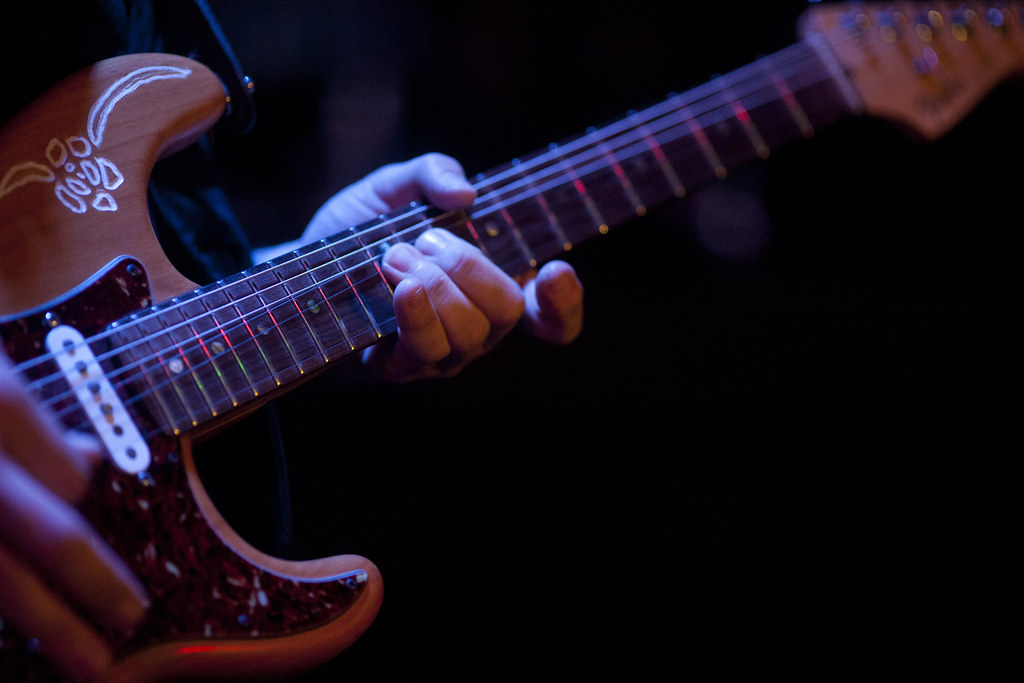
This is counter to the more appealing SXSW narrative — that it’s a place for fans to discover and bands to get discovered, one way or another. But mostly the only acts packing in crowds were discovered long before they made it to Austin.
Just before Anchondo and company go on, TV on the Radio plays over the house speakers — a band that just 14 hours prior had people lining up on the street to get into Stubb’s.
It’s not quite disappointment, more like quiet acceptance that this is just the way it is.
The band kicks off with a stomping blues rocker, just Anchondo and his guitar, backed by a quarter-note percussion line. He feels in tune with his guitar in a way that not many guitarists, even in the blues genre, can boast. It’s less like Anchondo wields an instrument and more like the it’s an extension of himself, like a harmonic third arm.
And that relationship carries the set. Anchondo’s guitarwork feels equal parts natural and fiercely-trained on selections like “Tall Glass of Whiskey,” a swinging country rocker from the group’s December release Young Guns.
Anchondo and crew make an energetic, serious performance seem innate, as though there is no phoning it in, no other possible mode of playing. Even to an empty bar. If there’s any champion of SXSW, it’s not the up-and-coming Courtney Barnett, playing a handful of shows this week, or the well-established Spoon. It’s the several hundred acts playing to nearly nobody and still somehow coming out on top.
—Jacob Zlomke
photos by Andrew Dickinson
* * *
Orenda Fink at Stay Gold
photos by Chris Dinan
* * *
Twinsmith at Stay Gold
photos by Chris Dinan
* * *
Vince Staples at Mohawk
photos by Bridget McQuillan
* * *
Colony House at the IFC Fairgrounds
photo by Bridget McQuillan
* * *
Jack Garrett at Red Eyed Fly
photo by Chris Dinan
* * *
The Velvet Teen at Cheer Up Charlie’s
photo by Andrew Dickinson
* * *
Big Harp at Maggie Mae’s
As we mentioned when they unveiled their new sound in December, the surprise of coming to any Big Harp show is whether the band will still be interested in the same kind of music you saw them play last year.
The music for the forthcoming third album seems composed of entirely moving parts, with too many ascending or descending notes to be considered riffs or grooves. Husband-wife duo Chris Senseney and Stefanie Drootin-Senseney (also of The Good Life) now work with their guitar and basses both as lead instruments with Daniel Ocanto (formerly of Gus & Call) on drums.
Seeing them twice in Omaha this winter, you knew Ocanto would work well in their ranks. What was clear last night in the expansive, dark room of Maggie Mae’s is that after a tour, he could be in charge, the bandleader in a sense. The airtight pounding and concussive kit work is actually the most coherent thing about the songs these days, locking them into some sort of pattern, and letting the melodies hasten around free.
There’s room for experimentation, too. In an unreleasd song — perhaps called “Golden Age”? — Drootin-Senseney pedaled an effect on and off every few seconds with the phrasing. There’s frantic professionalism here, too tight to be sloppy, but fighting that direction for excitement’s sake.
At the end of the set, Chris did everything but smash his guitar, ripping the strap off and swinging it dismissively over his shoulder, like a bag of refuse he doesn’t want.
—Chance Solem-Pfeifer
photos by Bridget McQuillan
* * *
Milo Greene at Velveeta Room
photos by Bridget McQuillan
* * *
Son Lux at Mohawk
photo by Bridget McQuillan
* * *
Milky Chance at Stubb’s
photos by Bridget McQuillan
* * *
The Mynabirds at Mohawk
photo by Bridget McQuillan
* * *
Sales at The Hilton, 18th Floor
photos by Chris Dinan
* * *
Doomtree Showcase at Karma Lounge
Certainly, SXSW boasts its share of themed showcases: Americana billings, rock billings, hip-hop billings. And then there are your showcases that seem themed only around what will draw, which I assume is how you get Vince Staples following Waxahatchee.
Doomtree’s showcase at Karma Lounge felt like a house party where all the guests had some inside scoop. The Minneapolis hip-hop group and label — bookended a night that also featured sets by each of its five emcees. Dessa, POS, Mike Mictlan, Cecil Otter, Sims, Paper Tiger and Lazerbeak would be in the wind all night, supporting each other’s sets, ordering drinks, mingling.
By contrast to the group’s towering Maha 2014 performance, performers and audience members alike appeared euphoric with how on-top-of-each-other they were. Moreover, the titanic dubstep bass drops that define the beat go down easier in a small room, where they seem to occur naturally, as much a part of the band (and not a prescription) as Sims’ constant bunny hopping, Mictlan’s menacing, cross-armed looks or Otter’s stoic set-long lean on the mic stand.
Group showcases like “Cabin Killer” and “Bolt Cutter” highlighted Doomtree’s revolving door onstage style, with the best testament to how much each emcee loves this, being when they rap each other’s lines off mic. Just for the communion of it.
An hour later, Dessa brought the crowd to a fever pitch when she climbed onto Karma’s bar — further and heightened enshrinement for an already statuesque performer — to deliver, downward to the people, a passionate rendition of “Call Off Your Ghost.”
—Chance Solem-Pfeifer
photo by Chris Dinan
* * *
METZ at Cedar Street Courtyard
photos by Chris Dinan
* * *
Hooligan Showcase at The Eastern
In its third year, the SXSW Hooligan Showcase, hosted by Omaha rapper Jimmy Hooligan, feels like a true, and rare, community event at a festival that outgrew organic camaraderie years ago.
Two days and dozens of sets by rappers, DJs and R&B crooners from around the country, the Hooligan Showcase is like a high school reunion or scene caucus for a farflung group. Sets are quick-fire highlight reels, limited to ten minutes each. Every act gets to, essentially, show what they’ve been up to.
And that makes Jimmy the homecoming king, the party leader. While every performer we caught had a faithful and engaged crowd in the The Eastern’s beer garden, it was Jimmy Hooligan who drew the most fervent support with nearly the whole audience rapping along to songs from his “DAWB” mixtape.

Fellow Omahan Shishi Sakari followed up and capitalized on the crowd-love Jimmy Hooligan cultivated.
We can think of hip-hop as, at least in-part, the domain of the disenfranchised. At its best, it’s a tool used to express frustration and anger through poetry and musical subversion. With its R&B roots, the tool has been historically implemented by African-American males but Shishi, whether knowingly or not, makes a strong claim on behalf of women’s rage, as well.
Her spitfire, snarling delivery dares any person to condescend to her skill. Her lyrics (“I don’t care what you say,” “fuck you,” etc.) are middle fingers that feel pointed at any person who built expectations about her based on gender. Atop a monitor, literal middle finger held high, she commands the stage more forcefully than nearly any other performer that evening.
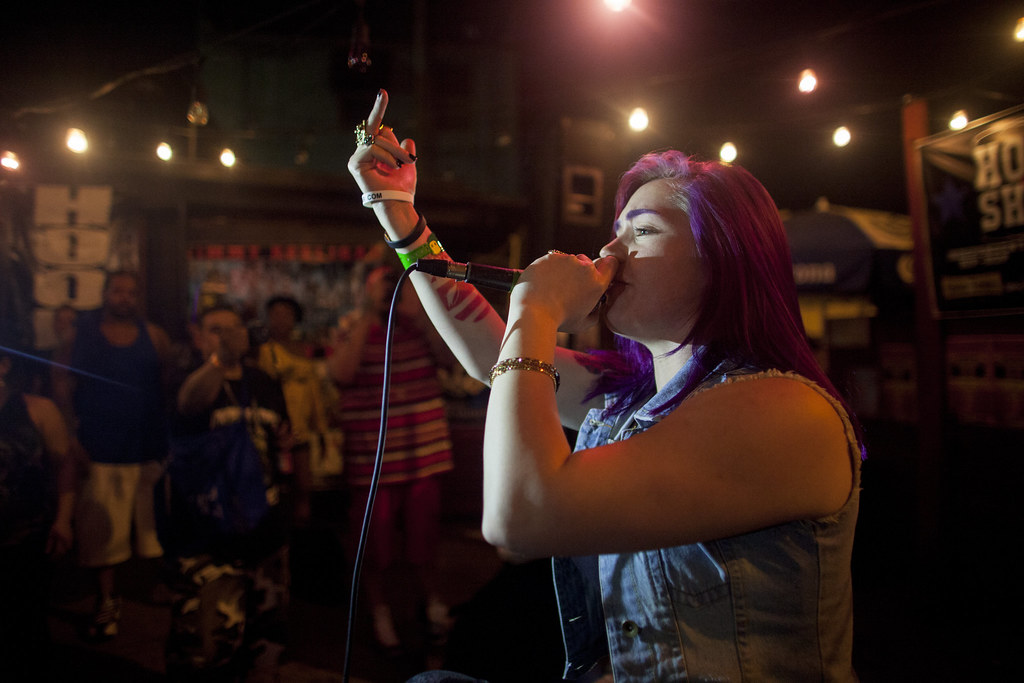
That rage, to see it flow out of her, to have Shishi invite the audience to share it, feels therapeutic for all.
And at the Hooligan Showcase, the loving community validates the anger, the sadness, the frustration. There’s a universal identification in those emotions that Shishi masterfully taps into.
—Jacob Zlomke
photos by Andrew Dickinson
* * *
Deerhoof at Cheer Up Charlie’s | Day and Night shows
About halfway through Deerhoof’s second Thursday set at Cheer Up Charlie’s (and third set of the day), drummer Greg Saunier stepped from behind the kit to the microphone, just as he had earlier in the day.
“When we were invited to play, we thought, why not fill it to the brim,” he says, beaming, regarding the band’s several shows this week. “We would never have conceived that we would be play this stage twice in one day and it would go this well.”
The San Francisco-based indie-prog band, which played at The Waiting Room last week with Of Montreal, is no anomaly. Spoon, Earl Sweatshirt, Waxahatchee, Icky Blossoms, Twinsmith, Mynabirds, Big Harp and scores of others are all filling their SXSW schedules to the brim.
What sounds like a hellish, marathon day in a swampy Texas heat actually seems to refresh Deerhoof. We caught up with Saunier after the show and he said they’ve prefered this stand to the city-to-city tour with Of Montreal.
“We’ve been driving seven hours every day, trying to keep up with Of Montreal everyday, who is in a bus and has someone driving them,” he says.
At SXSW, it’s a matter of walking down the street.
And seeing the band twice, it does feel like an accelerated version of a tour. The two setlists are generally the same with a variation in order. At the end of the day, the band’s movements are looser. Frontwoman Satomi Matsuzaki’s absurdist-workout-video dance moves feel more of the heart than the mind. In the afternoon, they seemed more like an obligation. As happens after singing in the upper register for three hours in a day, her voice is more worn down than it was in the afternoon.

But the odd time signatures and the blind-corner rhythm changes, led sometimes by Saunier and others by either guitarists John Dieterich or Ed Rodriguez, are as sharp as ever. The way Dieterich’s face seems to digest every note he fingers gives the impression he’s discovering these developments along with his audience.
Saunier says last time Deerhoof played SXSW, in 2013, they put on three shows in a day and found themselves anxious for it.
“We always thought of ourselves as kind of a persnickety band,” he says.
He was worried they would be too concerned tinkering with the sound, getting the mix just right. But when the time came, Deerhoof was able to just roll with it, which has helped them relax for shows since.
In that way, SXSW can act as a sort of low-risk training ground for a band like Deerhoof, who is certainly gaining national steam but is not as established as Spoon or TV on the Radio. Playing three shows in a day or 10 in a week is an intensive boot camp where you have to go with the flow and have your shit together even when other factors don’t.
And you’re welcome to try out some different approaches.
At the beginning of Deerhoof’s first set, Matsuzaki steps to the mic.
She says: “OK. Deerhoof.” And like that, the band swells. Later, the band doesn’t even give itself that modest of an intro. Playing late at night, right before Of Montreal, as they have been every night for a couple weeks now, they’re perhaps more recognizable. The crowd is purposefully here to see Deerhoof.
In the afternoon, when Saunier steps to the microphone after a bout of cheers from the crowd, the training grounds seem to be paying off.
“You do a thing and someone yells ‘Yeah! Do that thing!’” he says, “It feels good especially because you already did it, you already thought of it.”
—Jacob Zlomke
photos by Andrew Dickinson
* * *
Of Montreal at Cheer Up Charlie’s
photo by Andrew Dickinson
* * *
Hamilton Leithauser at Mohawk
A small self-satisfied exhale and a brow wipe — how often is this the dessert to a singer’s aria? Nothing showy, but akin to, “Ok, woosh, that wasn’t easy. Time for the next song.”
Hamilton Leithauser reflected on his ripped-up sustained notes looking like he just paid a parking ticket. A half dozen times, the former Walkmen singer clenched his shoulders into a foot-on-the-monitor rock star pose. Then, he put the mic back on the stand, put his hands in his pockets and stared blankly. Not standoffish or apathetic so much as unimpressed with how routinely he made a certain kind of cracking vocal danger seem like a day job.
Leithauser’s debut solo album, 2014’s Black Hours, is a business-cool showcase for his vocal prowess and small smiles of songs about autonomy and distaste.
Tall, sharply dressed and regal there were moments when the band seemed happy to let Leithauser have such vocal prominence that it recalled lounge-singing. Most of all when he covered Frank Sinatra’s “All Or Nothing At All” with beautiful restraint over both some pretty and a little atonal guitar work.
—Chance Solem-Pfeifer
photo by Chris Dinan
* * *
Laura Marling at Mohawk
The odd undercurrent of energy last night’s Laura Marling performance wasn’t that she was bored of her old songs — the earnest, bare folk that brought her to prominence in 2008. It’s that she seemed to intensely try and not be bored by them.
Playing “Devil’ Spoke” and “I Speak Because I Can” she poetically and rattled through her old lyrics, throwing her chin up at the end of phrases, as if to spit new meaning into them. As if relying on her vulnerable, soul voice would give an old feeling too much credit.
As far as sonic evolution, 2013’s I Once Was An Eagle clearly marked Marling’s commitment to more intricate folk, rerouting acoustic jazz and blues progressions.
At age 25, Marling’s Short Movie will be her fifth record, and it’s out next week. When she played its songs, especially the single “False Hope,” her band dug in, riding the grooves around Marling’s bluesy fretboard clawing on her Richenbacher. It’s a far cry from where American audiences started with Marling.
—Chance Solem-Pfeifer
photos by Chris Dinan




